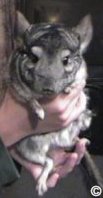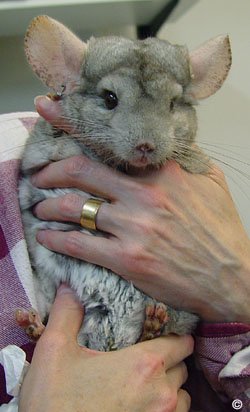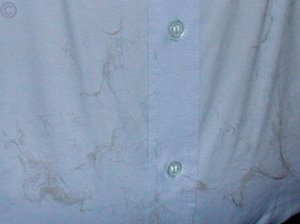 Although chinchillas are not sedentary animals and are not overly keen on being held, there are times when you need to hold a chinchilla confidently.
Although chinchillas are not sedentary animals and are not overly keen on being held, there are times when you need to hold a chinchilla confidently.
When you first buy a chinchilla you should perform an examination and during this time you will need to be able to hold a chinchilla properly. It is also good to hold a chinchilla regularly as there will be times when you need to go to the vet and it also helps towards your social bonding together.
Holding a Chinchilla
When holding a chinchilla the most important thing to be aware of is to not hold or grab a chinchilla by the tip of its tail. Holding or grabbing the tip of a chinchilla's tail will cause it to easily snap and break off!
When you first buy a chinchilla or a chinchilla is not familiar with you, they will become frightened and hide in a corner if not approached slowly. Approach the cage in a calm manner and slowly open the door. Place your hand inside the cage and after a short time the chinchilla will come up to you - do not try and hold a chinchilla at this point or it may bite you or if it's a female 'spray urine' at you. A chinchilla will begin to sniff your fingers and if left long enough, jump onto your hand and start exploring your arm.
There are various ways to hold a chinchilla and the best way of picking up a chinchilla is to slowly and firmly scoop the chinchilla up in both hands from underneath. Be prepared as chinchillas are seriously quick and easily jump out of your hands!
 Once a chinchilla is in your hands bring it close to your chest, which will help support the chinchilla's underbelly and reduce the amount of wriggling it will initially do.
Once a chinchilla is in your hands bring it close to your chest, which will help support the chinchilla's underbelly and reduce the amount of wriggling it will initially do.
Chinchillas don't like to be dangled or their legs to 'hang free' so make sure they are always supported. With one hand kept on top of the chinchilla you have another hand free to either perform an examination or stroke the chinchilla and begin bonding.
Another way you can hold a chinchilla (although it's not very comfortable or friendly), is to place one hand in front of the chinchilla and the other around the back and holding the tail firmly by its base before slowly picking them up. This is not a great way of holding a chinchilla though as they are mainly left to dangle upside-down, which they hate and is dangerous for a female chinchilla incase she is pregnant.
When you are holding a chinchilla you must be attentive at all times. If a chinchilla feels there is anyway they can wriggle or jump free then they will do so. If a chinchilla falls a great height you can cause the onset of tooth disorders such as malocclusion, head trauma, jawbone fracture, lacerations amongst other serious injuries.
To encourage a chinchilla to enjoy being held and to help towards repeated behavior, it is good to offer a small treat when putting them back down. This is one time we would recommend the use of a safe treat in the initial stages as the chinchilla will associate a treat with being picked up and this should make the process easier over time.
Holding a Pregnant Chinchilla

Wherever possible it is best to avoid holding a pregnant chinchilla. A female chinchilla who may have liked to be held before becoming pregnant may not be so forth-willing if you try to do so during this time.
If you must hold a pregnant chinchilla handle the female gently. Pick her up carefully by cupping her into your hands before slowly lifting her and supporting her rear. Keep the female close to your chest and preferably only hold a pregnant chinchilla whilst remaining seated.
Never press into the pregnant female's abdomen area and make sure you have a firm but gentle hold - if a female chinchilla falls a great height from your hands, they must be taken to a veterinary surgeon immediately for a medical checkup to ensure the unborn foetuses are unharmed and still alive.
WARNING - A pregnant female should NEVER be picked up by the base of her tail as dangling a pregnant female chinchilla upside down can cause a spontaneous miscarriage.
Holding a Sick Chinchilla
When a chinchilla is sick they generally like to be left alone but in some instances they may need help or veterinary interaction. It is therefore important you feel confident to hold a sick chinchilla as they can pick up on any hesitation and a procedure that is generally stress-free becomes a chase around the cage.
A sick chinchilla will be more defensive and less willing to be held so always start by closing any open areas where a chinchilla can run and hide. Approach the sick chinchilla calmly and do not make any eye-to-eye contact. Keep talking quietly to the chinchilla as you quickly but gently scoop them up with both hands. Ensure the chinchilla feels secure and warm whilst holding them (by keeping them close to your chest) and if you have picked the chinchilla up for a veterinary trip, place a soft towel in the bottom of the carrier and a familiar smell such as a sprinkle of dust bath (a very welcomed calming treat when traveling).
All chinchillas if held incorrectly will wiggle, squeal and become extremely vocal. There will also be considerable fur loss, which will be clearly visible as it will cover your clothes. This sudden fur loss is known professionally as Fur Slip - a defense mechanism continued from the wild chinchilla. Fur Slip also occurs if you pick a chinchilla up by the scruff of its neck.
When picking up and holding any chinchilla always do so slowly, calmly and gently.
Chinchilla Fur Slip
 Fur Slip is the automatic release of patches of fur when caught or roughly handled. This condition should not be mistaken for Shedding, which is a natural process in chinchillas.
Fur Slip is the automatic release of patches of fur when caught or roughly handled. This condition should not be mistaken for Shedding, which is a natural process in chinchillas.
In the chinchilla's original habit they would use this defense mechanism against predators when caught. By suddenly releasing a clump of fur the chinchilla would have the chance to run off whilst the predator got left with nothing but a mouthful of fluff.
In captivity, chinchillas use this defense mechanism when trying to escape if being handled. It is either because the chinchilla is not used to be handled by a human, it is frightened or is being roughly handled. Another common cause is fighting amongst chinchillas and when a chinchilla knocks itself against something hard.
To prevent Fur Slip happening you should never grab a chinchilla un-expectantly and ensure there is a bond of trust built up before trying to hold the chinchilla. Always talk calmly to the chinchilla whilst holding him/her and offer a treat after the occasion so the chinchilla will begin to look at the experience as pleasurable rather than frightening. Keep aggressive chinchillas apart and ensure there are no objects that a chinchilla can collide with when running around at full speed.
Fur Slip does not pose any harm to a chinchilla, only ruins the appearance of the coat, which grows back within 6 months (approximately). Saying this Fur Slip should try and be avoided as it is generally a result of a chinchilla being scared, mishandled, hurt or caught, all of which is detrimental to a chinchilla's health.
Further Reading Relating To Holding a Chinchilla:
Catching a Chinchilla, Examining a Chinchilla, Shedding and Grooming, Taming a Chinchilla.


 Although chinchillas are not sedentary animals and are not overly keen on being held, there are times when you need to hold a chinchilla confidently.
Although chinchillas are not sedentary animals and are not overly keen on being held, there are times when you need to hold a chinchilla confidently. Once a chinchilla is in your hands bring it close to your chest, which will help support the chinchilla's underbelly and reduce the amount of wriggling it will initially do.
Once a chinchilla is in your hands bring it close to your chest, which will help support the chinchilla's underbelly and reduce the amount of wriggling it will initially do.
 Fur Slip is the automatic release of patches of fur when caught or roughly handled. This condition should not be mistaken for
Fur Slip is the automatic release of patches of fur when caught or roughly handled. This condition should not be mistaken for